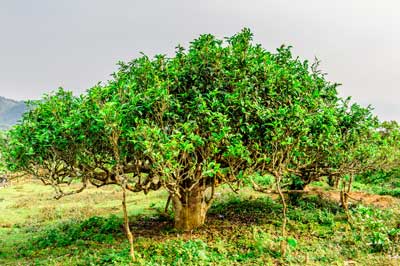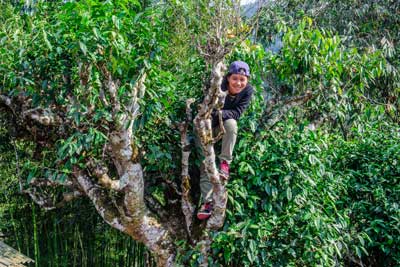Wild Tea Trees of Vietnam

It is generally accepted that the tea plant is native to parts of China, Assam (India), Myanmar (Burma), Thailand, Laos, Cambodia and Vietnam. In a number of these countries, including Vietnam, wild tea plants can still be found growing but are most likely relics of past cultivation rather than truly wild.

In Vietnam it is the mountainous area in the north of the country where wild tea trees can be found, usually growing in mixed forests on high mountain slopes. Significant wild tea areas exist in Dien Bien, Lai Chau, Lao Cai, Yen Bai and Ha Giang provinces reflecting the spread of one-time nomadic ethnic groups (particularly the H’Mong and Dao ethnic groups) whose habitation in these parts pre-dates any current geographic boundaries. It is believed that families carrying tea seeds with them as they moved from place to place is responsible for much of the current distribution.
There is also a story that an expansion of wild tea planting in the second half of the 19 th century was prompted by bags of tea being accepted as settlement of tax demands by the colonial French government. The alternative was to spend time working in government run factories.
Many extravagant claims are made about the age of tea trees. There are some in Vietnam that are said to have been dated to 800 years old but a best guess is that the majority are somewhere in the range of 80 to 150 years old. Differences in altitude, aspect, soil and climate means that trees grow at different rates making comparison difficult. Without human intervention trees may reach 4 or 5 metres in height. As the trees seed themselves you can also find younger trees but these take many years to reach maturity.
In Vietnam you will often found wild trees referred to as shan tuyet which translates literally to snow mountain. In theory a shan tuyet tea should mean that it is produced from old wild tree leaves but this is not always the case. It is also no guarantee of quality. In recent years, as the popularity of wild teas has grown (particularly demand from China), new plantings of wild trees have been made but at far greater density than the truly old trees. The older trees are typically found in mixed bio-diverse environments – often very remote, deep into the forest and only accessible on foot. All of our own teas are made with leaves harvested from old trees.
The climate in the far north of Vietnam is sub-tropical but at altitudes of 1300 metres and above there is more variation in temperature. The mountains are often shrouded in mists causing trees to grow more slowly. Even so the trees can grow up to and beyond 5 metres making it necessary to climb into the trees to harvest the leaves.

Wild trees are typically on land cared for by ethnic minority families who will also take responsibility for harvesting the fresh leaves (there is usually no other human intervention other than harvesting.) Families may then process the leaves themselves or sell to other families or factories for processing. With demand for leaves high there is always plenty of selling options and it remains as useful source of income.
Having good source material (leaves) only goes some way to making a great tea. The real difference comes from the skill of the tea maker. You can visit any tea district and find a range of qualities on offer from average to excellent. That is where the advantage of careful selection comes in.
Old trees with deep roots and slow growth give these wild mountain teas their special character which can be very different to farm grown equivalents. A wild tea may not have the same intensity from the first steep but it will continue to develop, have greater depth and complexity and deliver flavour for longer.
Wild teas can be an acquired taste but when you have discovered a good one there can be no going back.

